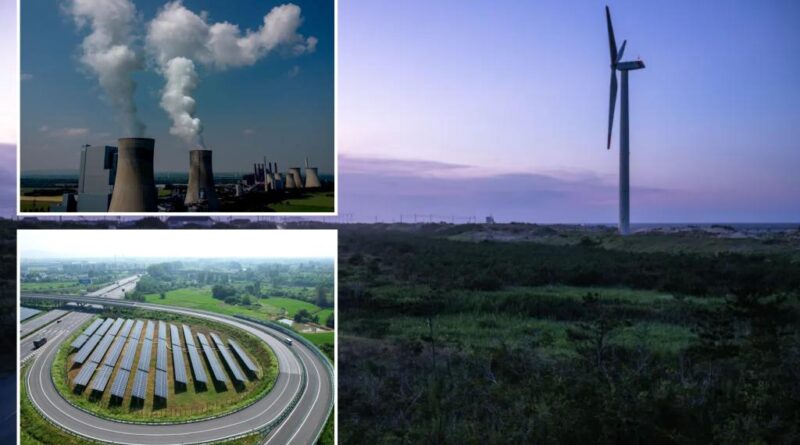We waste $2 trillion a year chasing ‘green’ ideas
Despite much congestion, the much-vaunted transition of green energy away from fossil fuels is not happening.
Achieving meaningful change with current policies seems impossible. We need a radical change in policy direction.
Globally, we now spend about $2 trillion annually to try to force the energy transition. In the last decade, the use of solar and wind energy has increased to the highest levels.
But it has not reduced the old fuel – on the contrary, we have increased even Again fat at the same time.
Many studies show that when nations increase renewable energy, most of it does not replace coal, gas or oil. It just increases energy consumption. Recent studies show that for every six parts of new green energy, less than one part replaces any fossil fuel. Studies in the United States show that renewable energy subsidies increase overall energy consumption.
In other words, policies aimed at boosting green energy lead to more production.
None of this should surprise any student of history. During the transition from wood to coal in the 1800s, overall wood consumption increased even as coal accounted for a larger share of energy needs. The same thing happened when we moved from coal to oil: in 1970, oil, coal, gas and wood. all he gave more power than before.
People have an unquenchable thirst for cheap energy, which is needed in every aspect of modern life. In the last fifty years, our oil and coal energy has doubled, hydroelectricity has tripled, and natural gas has quadrupled – and we’ve had an explosion of nuclear power. , sun and wind. The whole world – and the common man – has never had more power.
The main agenda behind today’s green energy transition mainly insists that pushing renewables everywhere will run out of fossil fuels.
But a recent study concluded that talk of change is “misleading.” During each past addition of a new energy source, the researchers found, “it has been unprecedented for these additions to cause a steady decline in resource consumption of established power.”
What makes us change the way we use energy?
One study investigated 14 shifts that have occurred over the past five hundred years, such as when farmers moved from fields and livestock to tractors running on fuel. The main driver has always been that the new energy service is better or cheaper.
Sun and wind fail on both counts. They are no better, because unlike fossil fuels that can generate electricity whenever we need it, they can generate energy depending on the weather and the sun.
This means they are not cheap, either. In fact, they are only cheap when the sun is shining or the wind is blowing at the right speed. The rest of the time they are often useless and expensive.
When we consider the cost of just four hours of storage, wind and solar energy solutions are revolutionary which requires competition compared to fossil fuels. Achieving a real, sustainable change to the sun or wind will require orders of magnitude more storage, making these options surprisingly unavailable.
Furthermore, solar and wind only address a small part of the larger challenge. They are almost entirely used in the electricity sector, which accounts for only one fifth of the world’s energy consumption.
We are still struggling to find green solutions for mass transportation, and we haven’t even started on the massive energy needs of heating, manufacturing, or agriculture. We all ignore the most difficult and important sectors like steel, cement, plastic and fertilizer.
It’s no surprise that, for all the world’s talk of an energy revolution, even the Biden Administration finds that while renewable energy sources will increase dramatically worldwide through 2050, oil , gas and coal will all increase, too.
In this case, we will never achieve an energy transition away from fossil fuels. This would require massive subsidies for solar and wind, as well as batteries and hydrogen, and for us all to adopt less efficient technologies for essential needs like iron and fertilizer.
But on top of that, real change would require politicians to impose huge taxes on fossil fuels to make them unpopular. McKinsey estimates the direct price-tag to achieve real change at more than $5 trillion annually. This recession will slow economic growth, making real costs five times higher. Annual costs for people living in wealthy countries can be as high as $13,000 per person per year.
Voters will not agree with that pain.
The only real way to achieve change is to significantly improve other forms of green energy. This means more investment in research and development of green energy. Innovation is needed in wind and solar, but also in storage, nuclear power, and many other potential solutions. Bringing alternative energy costs below the cost of fossil fuels is the only way a green solution can be used globally, not just by elites in a few climate-conscious countries, countries rich ones.
When politicians tell you that the green revolution is here and we need to get on board, they are really asking voters to support them in throwing more good money after bad. We need to be smarter.
Bjorn Lomborg is President of the Copenhagen Accord, Visiting Fellow at Stanford University Hoover Institution, and author of “False Alarm”
#waste #trillion #year #chasing #green #ideas
